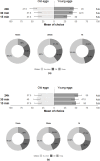What's my age again? Assessing the impact of stink bug egg mass age on host recognition by egg parasitoids Trissolcus basalis and Trissolcus japonicus (Hymenoptera: Scelionidae)
- PMID: 40746985
- PMCID: PMC12310635
- DOI: 10.3389/fphys.2025.1588946
What's my age again? Assessing the impact of stink bug egg mass age on host recognition by egg parasitoids Trissolcus basalis and Trissolcus japonicus (Hymenoptera: Scelionidae)
Abstract
Wasps, from the genus Trissolcus, are egg parasitoids that are commonly used in biological control programs targeting stink bugs. They navigate a complex environment, relying on a diverse array of biochemical and ecological cues to locate their hosts. Through this endeavour, these parasitoid wasps have to discriminate between young and old eggs as development is only achieved in the latter. In this study, we evaluated the ability of two parasitoid wasps, Trissolcus japonicus and Trissolcus basalis, on utilising short-range cues and, more specifically, volatile organic compounds emitted by stink bug egg masses to locate their hosts. We hypothesised that (1) stink bug eggs (i.e., Halyomorpha halys and Nezara viridula) emit short-range cues that are exploited by egg parasitoids (i.e., T. japonicus and T. basalis) to locate their hosts in addition to insect chemical footprints; (2) Trissolcus spp. Have the ability to differentiate young eggs from older ones to increase their fitness (3) based on changes in the chemical profiles of the egg masses according to their age. Our behavioural assays suggested that T. japonicus did not respond to stink bug footprints, whereas T. basalis was significantly oriented toward the footprints of gravid host females. Both parasitoids preferentially oriented towards young eggs rather than footprints. The parasitism rate of T. japonicus was not significantly different between young and old eggs unlike T. basalis which preferred parasitising on young eggs. We identified γ-butyrolactone and β-funebrene in the headspace of N. viridula eggs and we discussed the putative role of these secondary metabolites on T. basalis locating their host. Behavioural, performance and VOCs collection of this study contribute to a nuanced understanding of host-parasitoid dynamics along with implications for developing effective pest management strategies.
Keywords: biocontrol; chemotaxis; host recognition; short-range cues; trophic cascade; volatile organic compounds.
Copyright © 2025 Sion, Hiltpold, Cléroux, Verheggen and la Forgia.
Conflict of interest statement
The authors declare that the research was conducted in the absence of any commercial or financial relationships that could be construed as a potential conflict of interest.
Figures









Similar articles
-
Integrating Chemical Ecology with Behavioural Bioassays to Understand Host Preferences in the Stink Bug Egg Parasitoids Trissolcus basalis and Trissolcus oenone (Hymenoptera: Scelionidae).J Chem Ecol. 2025 May 28;51(3):60. doi: 10.1007/s10886-025-01616-z. J Chem Ecol. 2025. PMID: 40425981 Free PMC article.
-
Assessing the lethal effects of pesticide residue exposure on beneficial parasitoids and their host, Halyomorpha halys (Stål) (Hemiptera: Pentatomidae).J Econ Entomol. 2025 Feb 11;118(1):242-252. doi: 10.1093/jee/toae281. J Econ Entomol. 2025. PMID: 39774915
-
Classical biological control of the brown marmorated stink bug (Halyomorpha halys) in apple orchard: a success story.Pest Manag Sci. 2025 Aug 25. doi: 10.1002/ps.70154. Online ahead of print. Pest Manag Sci. 2025. PMID: 40851440
-
Systemic pharmacological treatments for chronic plaque psoriasis: a network meta-analysis.Cochrane Database Syst Rev. 2021 Apr 19;4(4):CD011535. doi: 10.1002/14651858.CD011535.pub4. Cochrane Database Syst Rev. 2021. Update in: Cochrane Database Syst Rev. 2022 May 23;5:CD011535. doi: 10.1002/14651858.CD011535.pub5. PMID: 33871055 Free PMC article. Updated.
-
Systemic treatments for metastatic cutaneous melanoma.Cochrane Database Syst Rev. 2018 Feb 6;2(2):CD011123. doi: 10.1002/14651858.CD011123.pub2. Cochrane Database Syst Rev. 2018. PMID: 29405038 Free PMC article.
References
-
- Awadalla S. S. (1996). Influence of temperature and age of Nezara viridula L. eggs on the scelionid egg parasitoid, trissolcus megallocephalus (ashm.) (hym., scelionidae). J. Appl. Entomol. 120 (1–5), 445–448. 10.1111/j.1439-0418.1996.tb01634.x - DOI
-
- Ayelo P. M., Mohamed S. A., Chailleux A., Yusuf A. A., Pirk C. W., Deletre E. (2022). The parasitoid Dolichogenidea gelechiidivoris eavesdrops on semiochemicals from its host tuta Absoluta and tomato. J. Pest Sci. 95 (2), 633–652. 10.1007/s10340-021-01424-w - DOI
-
- Blum M. S., Hilker M. (2003). Chemical protection of insect eggs. In: Hilker M., Meiners T., editors. Chemoecology of insect eggs and egg deposition. New York, NY: Wiley. p. 61–90. 10.1002/9780470760253.ch3 - DOI
-
- Colazza S., Aquila G., Pasquale C., Peri E., Millar J. (2007). The egg parasitoid Trissolcus basalis uses n-nonadecane, a cuticular hydrocarbon from its stink bug host Nezara viridula, to discriminate between female and Male hosts. J. Chem. Ecol. 33 (7), 1405–1420. 10.1007/s10886-007-9300-7 - DOI - PubMed
LinkOut - more resources
Full Text Sources
Miscellaneous

